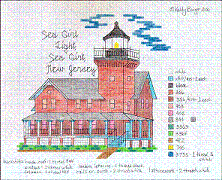Annapolis, Maryland
The Thomas Point Lighthouse was the last manned lighthouse on the Chesapeake Bay. It wasn’t fully automated until 1986. One of the few remaining screw-pile lighthouses in the Chesapeake Bay, this light has been recently opened for tours. Those wishing to visit this lighthouse must take a boat's ride out to the lighthouse due to the fact that it is about a half-mile from shore.
Presque Isle Lighthouse,
Presque Isle State Park,, Lake Erie, Pennsylvania
Work began on this lighthouse in 1872, but difficulties occurred in getting materials to the
construction site.
Finally the light was exhibited on July 12, 1873. The light station consisted of a square brick tower attached to a
two-story brick dwelling. A fourth-order Fresnel lens shone a fixed white light whose focal plane was 73 feet above
the lake level. Located on the outer, or lake side of a loop road, the light is now automated and the dwelling continues to
serve as a residence.
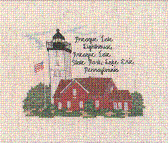
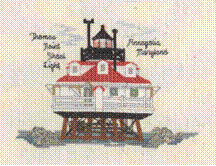
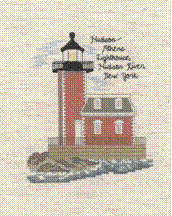
Fire Island National Seashore, New York
One of the more memorable stories
about the perils offshore of this lighthouse involves the wreck of the
British bark, Charlie Hickman. Carrying coal and empty petroleum barrels, it ran aground a few hundred
yards offshore. With the ship breaking up, the crew sought shelter in the sinking stern. A light was seen by
the lighthouse crew and they rushed to rescue the men. A rope was rigged with a life preserver attached, that enabled
the crew to make it to shore. All but one survived--a young crewman who was sucked away from helping hands.
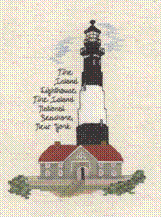
Hudson River, New York
This lighthouse is listed in the Coast Guard’s Light List as being at Hudson, an old whaling port about 100 miles upriver from New York City. It was erected in 1874 in the center of the river at to protect merchant ships from middle-ground flats in the river which are hazardous because they are barely visible at certain points. It is believed that its design was derived from the successes/failures at the other lighthouses. Its pier took different shape so the ice that flowed down the river would hit the extended section and not damage the foundation or the structure, as had been the case at the lighthouse in Esopus Meadows.
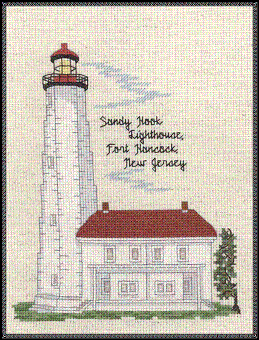
Located at the south point of the entrance to New York Harbor, it is the oldest of colonial lighthouses still standing. The original masonry tower is standing with apparently no exterior change. It is a dignified and massive structure, octagonal in form, the walls being seven feet thick at the base, 29 feet in diameter, of stone lined inside with brick. the tower was at the top is 15 feet in diameter. It has survived 235 years and is still guiding mariners.
New York City, New York
Jeffrey's Hook Lighthouse became widely known as the children's literary landmark, "The Little Red Lighthouse." The story of the lighthouse in Fort Washington Park was popularized by the book The Little Red Lighthouse and The Great Gray Bridge, published in 1942. In the fictional account, Jeffrey's Hook was a symbol of the significance of a small thing in a big world. The lighthouse became a celebrated "child's landmark", representing importance and permanence.
Long Island, New York
Montauk Point Lighthouse is the oldest lighthouse in New York State and the fourth oldest in the country, authorized by President George Washington in 1792. The builder was John McComb, Jr. who built the first Cape Henry light in Virginia. Built of sandstone blocks from Connecticut, "Chatham freestone, fine hammered", construction was completed on November 5, 1798, and has been part of long Island's land and seascape for over 200 years.
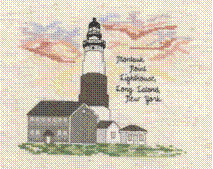
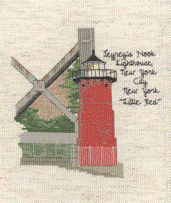
Sea Girt, New Jersey
This quaint little lighthouse sits right across the
boardwalk from the Atlantic Ocean, and lies between Absecon Lighthouse to its south, and the Twin Lights of
Navesink to its north The lantern room sits 60 feet above the high-water mark. It has/had a fourth order Fresnel
flashing red lens that flashed every six seconds. The first radio fog beacon was installed here in 1921, in part
to aid ships approaching New York Harbor.
